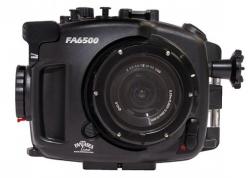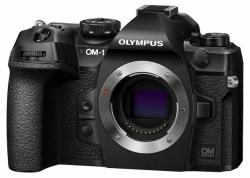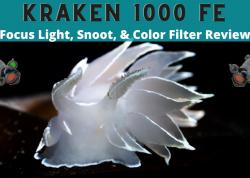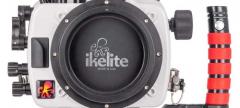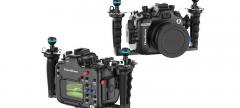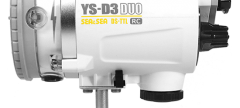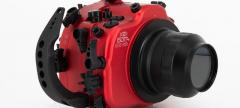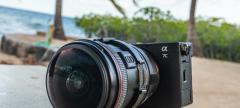Olympus 9-18mm Lens Review
By Kelli Dickinson

Olympus 9-18mm @ 9mm, 1/60 F6.3
For micro four-third's shooters there are a variety of wide angle lenses to choose from, with perks and negatives with each lens. How do you decide which lens is right for you? Here is a quick review on one of the popular choices, the Olympus M.Zuiko 9-18mm.
I tested this lens last month out at Catalina. Until then I have been using the Panasonic 8mm fisheye for wide angle, so this review will compare the two of those. There is the also the Panasonic 7-14mm lens as a great option for wide angle, but it's price point tends to make it not so popular. If you have the money and want a little extra angle of view, it's definitely worth a look!
"Diver with Gorgonian" - a classic wide angle shot, easy to achieve with the 9-18mm lens.(1/80, F8 with lens @ 9mm)
Olympus 9-18mm lens - Quick Specs:
| 9-18mm | 8mm Fisheye |
Lens Type | Wide Zoom | Fisheye |
Angle of View | 100⁰ - 62⁰ | 180⁰ |
Minimum Focus Distance | 0.25 m (9.84") | 0.10 m (3.94") |
Maximum Aperature | F4-5.6 | F3.5 |
| | |
Zoom Capability
Overall, the Olympus M.Zuiko 9-18mm lens works great. Having a wide angle lens with zoom capability is great compared to the 8mm fisheye with no zoom capability. This lens gives you a little more flexibility because it is a zoom lens which allows you to shoot animals or other subjects that you canít get close to. With the 8mm fisheye, everything looks a little bit smaller than it actually is due to the fisheye nature of the lens. This means you have to be able to get up close and personal to your subjects, especially if they are small to medium in size.
Dramatic Effect
One area where the 9-18 just doesnít compare with the 8mm fisheye in terms of dramatic scenes. The 9-18mm is a rectilinear lens, meaning that you don't see any distortion (bending of straight lines) like you do with the fisheye lens. However, that also means that the angle of view is limited to standard focal length proportions, so at 9mm you get approximately 100 degrees angle of view and when zoomed into 18mm it drops to around 60 degrees.
This is still fabulous and for most wide angle shots will work great, but it just doesn't portray the depth and grandeur that the 180 degree field of view of the 8mm fisheye captures. While I have not had a chance to test it yet, the 7-14 gives an extra 10 degrees field of view and has the same minimum focus distance as the 9-18, making it a little better choice for wide angle, but it is also about twice as expensive of a lens.
"Sheephead and Gorgonian" - take an 9mm close to the gorgonian the image has good depth, but just doesn't compare to the 180 degree field of view on the 8mm fisheye, below. (Olympus 9-18mm @ 9mm, 1/80, F8)
"Sheephead in Kelp" - the 8mm fisheye has such a wide angle of view that it easily captures the whole scene. Of course this also means you have to really think about shot composition to create some stunning images. (Panasonic 8mm Fisheye, 1/60, F18)
Close Focus Wide Angle
What I found to be the largest downside was the focus distance. The 9-18mm focuses only down to .25m, about 9.8in where as the 8mm fisheye has a focus distance of .1m or about 3.9in. This means you can't get right up on the dome port with the 9-18mm like you can with the 8mm fisheye for close focus wide angle. One thing I love about the 8mm is getting in super close, but still being able to see the full background of the scene.
Focus speed is good, on par with any other M4/3rd's lens, and I noticed no hunting, making for quick and easy use.
Sharpness
I did notice that there was some blurring in the corners with the 9-18mm which I do not see on the 8mm fisheye (not including standard depth of field blurring). This seemed to happen mostly with the lower apertures over the higher ones. Nothing that I found too distracting, but it is noticeable.
Olympus 9-18mm @ 9mm, 1/60, F11
Conclusion
My final thoughts on this lens is that it is a great option for those dives when you are shooting animals or other subjects that you cannot get right up close to, but for reef scenes and general wide angle the 8mm fisheye still gets my vote. Having the flexibility of the 9-18mm is wonderful, but doesn't trump the 180 degree field of view of the 8mm fisheye.
About the Author
Kelli Dickinson is an avid diver, manager of Bluewater Photo Store and an industry expert on mirrorless cameras and housing options. You can reach her by email at kelli@bluewaterphotostore.com.
Further Reading
Where to Buy
Please support the Underwater Photography Guide by purchasing your underwater photography gear through our sister site, Bluewater Photo & Video. Click, or call them at (310) 633-5052 for expert advice!






 Visit Bluewater Photo & Video for all your underwater photography and video gear. Click, or call the team at (310) 633-5052 for expert advice!
Visit Bluewater Photo & Video for all your underwater photography and video gear. Click, or call the team at (310) 633-5052 for expert advice! Bluewater Travel is your full-service scuba travel agency. Let our expert advisers plan and book your next dive vacation. Run by divers, for divers.
Bluewater Travel is your full-service scuba travel agency. Let our expert advisers plan and book your next dive vacation. Run by divers, for divers.




